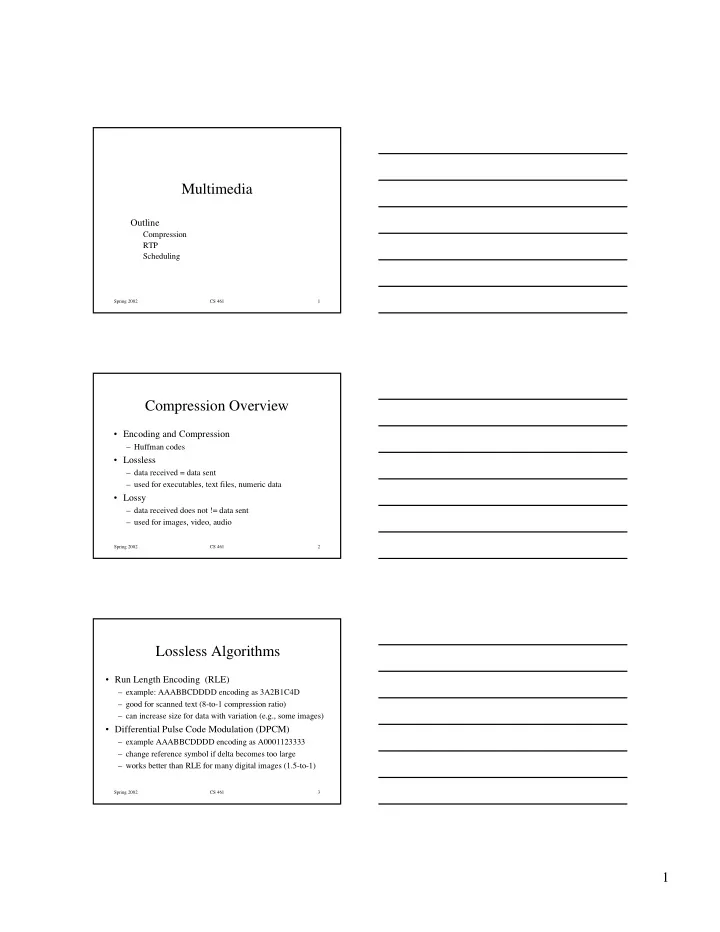

Multimedia Outline Compression RTP Scheduling� Spring�2002 CS�461 1 Compression�Overview • Encoding�and�Compression – Huffman�codes • Lossless� – data�received�=�data�sent – used�for�executables,�text�files,�numeric�data • Lossy – data�received�does�not�!=�data�sent – used�for�images,�video,�audio Spring�2002 CS�461 2 Lossless Algorithms� • Run�Length�Encoding��(RLE) – example:�AAABBCDDDD�encoding�as�3A2B1C4D� – good�for�scanned�text�(8-to-1�compression�ratio)� – can�increase�size�for�data�with�variation�(e.g.,�some�images) • Differential�Pulse�Code�Modulation�(DPCM) – example�AAABBCDDDD�encoding�as�A0001123333 – change�reference�symbol�if�delta�becomes�too�large – works�better�than�RLE�for�many�digital�images�(1.5-to-1) Spring�2002 CS�461 3 1
Dictionary-Based�Methods • Build�dictionary�of�common�terms� – variable�length�strings • Transmit�index�into�dictionary�for�each�term� • Lempel-Ziv�(LZ)�is�the�best-known�example • Commonly�achieve�2-to-1�ration�on�text • Variation�of�LZ�used�to�compress�GIF�images – first�reduce��24-bit�color�to�8-bit�color� – treat�common�sequence�of�pixels�as�terms�in�dictionary – not�uncommon�to�achieve�10-to-1�compression�( x 3) Spring�2002 CS�461 4 Image�Compression� • JPEG:�Joint�Photographic�Expert�Group�(ISO/ITU) • Lossy�still-image�compression� • Three�phase�process JPEG�compression Source Compressed image image DCT Quantization Encoding – process�in�8x8�block�chunks�(macro-block) – grayscale:�each�pixel�is�three�values�(YUV) – DCT:�transforms�signal�from�spatial�domain�into�and� equivalent�signal�in�the�frequency�domain�(loss-less) – apply�a�quantization to�the�results�(lossy)� – RLE-like�encoding�(loss-less)� Spring�2002 CS�461 5 Quantization�and�Encoding • Quantization Table 3������5�����7�����9�����11���13���15���17 5������7�����9�����11���13���15���17���19 7������9�����11���13���15���17���19���21 9������11���13���15���17���19���21���23 11����13���15���17���19���21���23���25 13����15���17���19���21���23���25���27 15����17���19���21���23���25���27���29 17����19���21���23���25���27���29���31 • Encoding�Pattern Spring�2002 CS�461 6 2
MPEG • Motion�Picture�Expert�Group • Lossy�compression�of�video� • First�approximation:�JPEG�on�each�frame • Also�remove�inter-frame�redundancy� Spring�2002 CS�461 7 MPEG�(cont) • Frame�types – I�frames:�intrapicture� – P�frames:�predicted�picture – B�frames:�bidirectional�predicted�picture� Input Frame�1 Frame�2 Frame�3 Frame�4 Frame�5 Frame�6 Frame�7 stream MPEG compression Forward prediction Compressed I�frame� B�frame B�frame P�frame B�frame B�frame I�frame stream Bidirectional prediction • Example�sequence�transmitted�as�I�P�B�B�I�B�B Spring�2002 CS�461 8 MPEG�(cont) • B�and�P�frames – coordinate�for�the�macroblock�in�the�frame – motion�vector�relative�to�previous�reference�frame�(B,�P) – motion�vector�relative�to�subsequent�reference�frame�(B) – delta�for�each�pixel�in�the�macro�block� • Effectiveness – typically�90-to-1 – as�high�as�150-to-1 – 30-to-1�for�I�frames – P�and�B�frames�get�another�3�to�5 x Spring�2002 CS�461 9 3
MP3 • CD�Quality – 44.1�kHz�sampling�rate – 2� x 44.1� x 1000� x 16�=�1.41�Mbps – 49/16� x 1.41�Mbps�=�4.32�Mbps • Strategy – split�into�some�number�of�frequency�bands – divide�each�subband�into�a�sequence�of�blocks – encode�each�block�using�DCT�+�Quantization +�Huffman – trick:�how�many�bits�assigned�to�each�subband Spring�2002 CS�461 10 RTP • Application-Level�Framing • Data�Packets – sequence�number – timestamp�(app�defines�“tick”) • Control�Packets�(send�periodically) – loss�rate�(fraction�of�packets�received�since�last�report) – measured�jitter� Spring�2002 CS�461 11 Transmitting�MPEG • Adapt�the�encoding – resolution – frame�rate – quantization�table – GOP�mix • Packetization • Dealing�with�loss • GOP-induced�latency Spring�2002 CS�461 12 4
Layered�Video • Layered�encodeing – e.g.,�wavelet�encoded • Receiver�Layered�Multicast�(RLM) – transmit�each�layer�to�a�different�group�address – receivers�subscribe�to�the�groups�they�can�“afford” – Probe�to�learn�if�you�can�afford�next�higher�group/layer • Smart�Packet�Dropper�(multicast�or�unicast) – select�layers�to�send/drop�based�on�observed�congestion – observe�directly�or�use�RTP�feedback Spring�2002 CS�461 13 Real-Time�Scheduling� • Priority� • Earliest�Deadline�First�(EDF) • Rate�Monotonic�(RM) • Proportional�Share – with�feedback – with�adjustments�for�deadlines� Spring�2002 CS�461 14 5
Recommend
More recommend